Best blues guitars 2025: these six-strings have the blues and they ain't bad
Wondering what the best blues guitars are at the moment? Here we have 10 of the finest options from Gibson, Fender, Guild and more
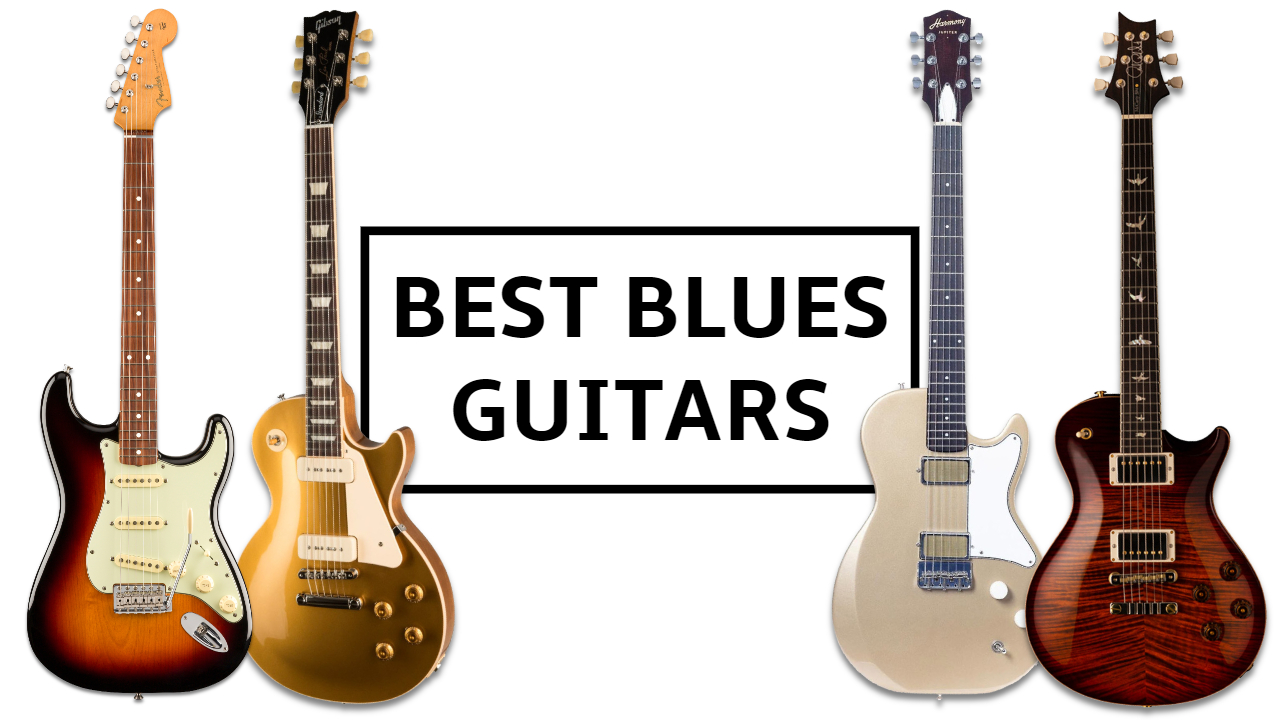
Compiling a list of the best blues guitars isn’t difficult. You can draft a long list of contenders by simply moseying on over to your record collection and picking out some of the classic albums. If the guitar isn’t on the cover with the artist, then sure as sugar it’ll be on the back of the sleeve.
Alternatively, sift through YouTube. You could start with the Kings – Albert, B.B. and Freddie. Then you could move on to Stevie Ray Vaughan, Peter Green, Eric Clapton and Buddy Guy. Or you could forget all of that and take a digital tour of Joe Bonamassa’s Nerdville. Not only is Bonamassa the marquee name in contemporary blues, he’s got all the good stuff, too.
The point is: we see great blues guitars everywhere, and oftentimes we’re even familiar with their origin stories. Where, for instance, is Beano, Clapton’s long-stolen Burst? (Many guitarists will have their own theories.) When you think of the blues, the first name that comes to mind is B.B. King. The second is Lucille, his iconic Gibson ES-345 – a most regal instrument for the King of the Blues. That’s testimony to the lure of the blues guitar; the best are inextricably linked to the players. Maybe that’s true of all blues guitars, to a lesser degree.
If you’re looking for a guitar on which to play your own blues, wading through this tide of music history can be a grueling and dispiriting task, with comparable instruments from the same eras as the greats only found in the overheated vintage market.
But don’t let that get you down. We’ve drafted a list of great guitars for blues, and for all budgets, and we’ll even link to the best deals. This list features guitars of all different builds, but each of them will make a great blues guitar in the hands of the right player.
- Pair your axe with one of the best blues amps
- The best rock guitars from Gibson, Fender, Ibanez and others
Best blues guitars: Guitar World’s choice
Inspired By Gibson? The Epiphone 1959 Les Paul Standard is more than that. A joint venture by the Gibson Custom Shop and Epiphone, this limited-edition guitar is a formidable take on a legendary model. Featuring genuine Gibson USA Burstbucker pickups, its voice is bang on the money. A bona-fide heartbreaker.
If the early-’60s Stratocaster saw Leo Fender’s most tweakable tone machine at its best, then the Vintera series is a 21st-century time capsule that updates the classic template for today’s budget-conscious player. With a trio of single-coils designed by the esteemed Tim Shaw, the Fender Vintera ’60s Strat has all the spank, chime and gnarly bite that you could want from a blues guitar. It’s great fun to play, too.
Best blues guitars: Product guide
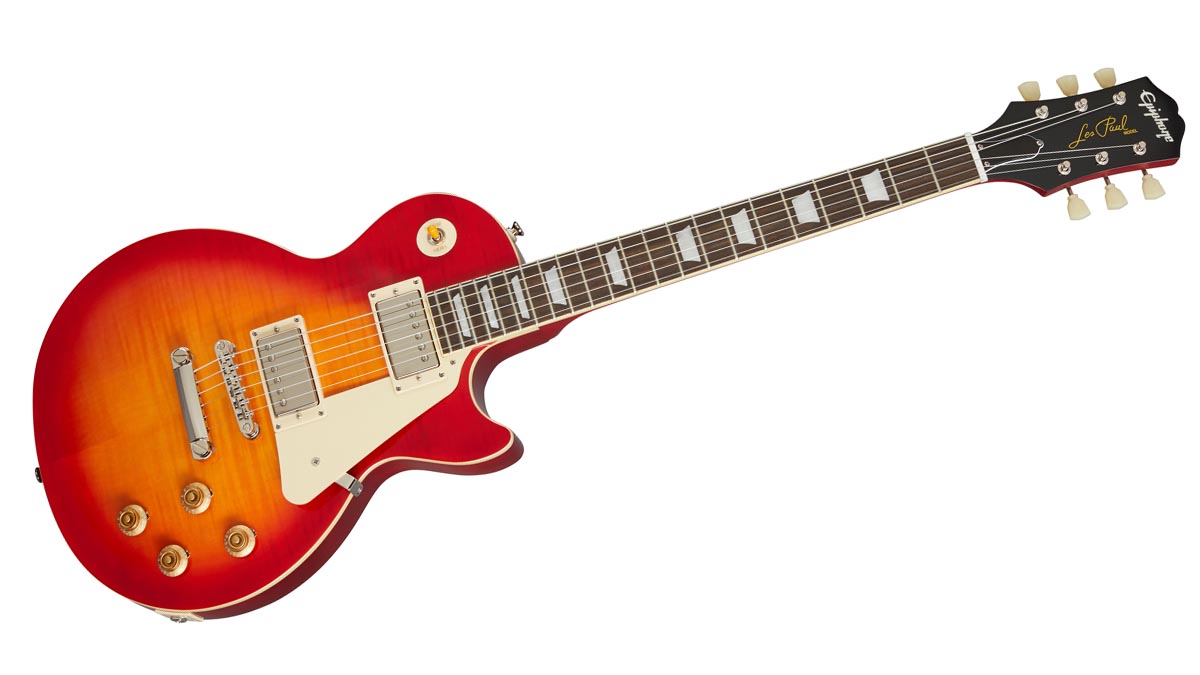
1. Epiphone 1959 Les Paul Standard
Our expert review:
Specifications
Reasons to buy
Reasons to avoid
A collaboration between the Gibson Custom Shop and Epiphone has sired one of the most candent stars in the Inspired By Gibson series. This take on the holiest of Holy Grail guitars is quite special indeed, and an incredible instrument in its own right. It taps into many of the design features that made the 1959 Gibson Les Paul Standard the most sought-after electric guitar in history.
Here you’ve got a cornucopia of period-inspired specs, chief among them the weight and dimensions. The body is a considerable slab of solid mahogany – right there you’ve got the guts of the tone – while an AAA flame maple cap, beautifully figured considering the list price and finished in VOS-esque aged gloss, sprinkles a little high-end fairy dust into the voice. The neck is glued to the body with an old-school long neck tenon, with everything geared towards the acme of Les Paul tone – i.e. warm, thick and creamy, with plenty of clarity and singing sustain. The neck is hand-rolled and is a very comfortable rounded medium C-profile.
A pair of genuine Gibson USA Burstbucker humbuckers are on hand to nail that PAF vibe, and these are connected to the controls with a ’50s-style wiring loom. It’s the little things that add up here: the Switchcraft selector switch and output jack, the CTS pots and the Mallory capacitors… This limited-edition Les Paul is a tone machine, and is testament to Epiphone’s hot streak.
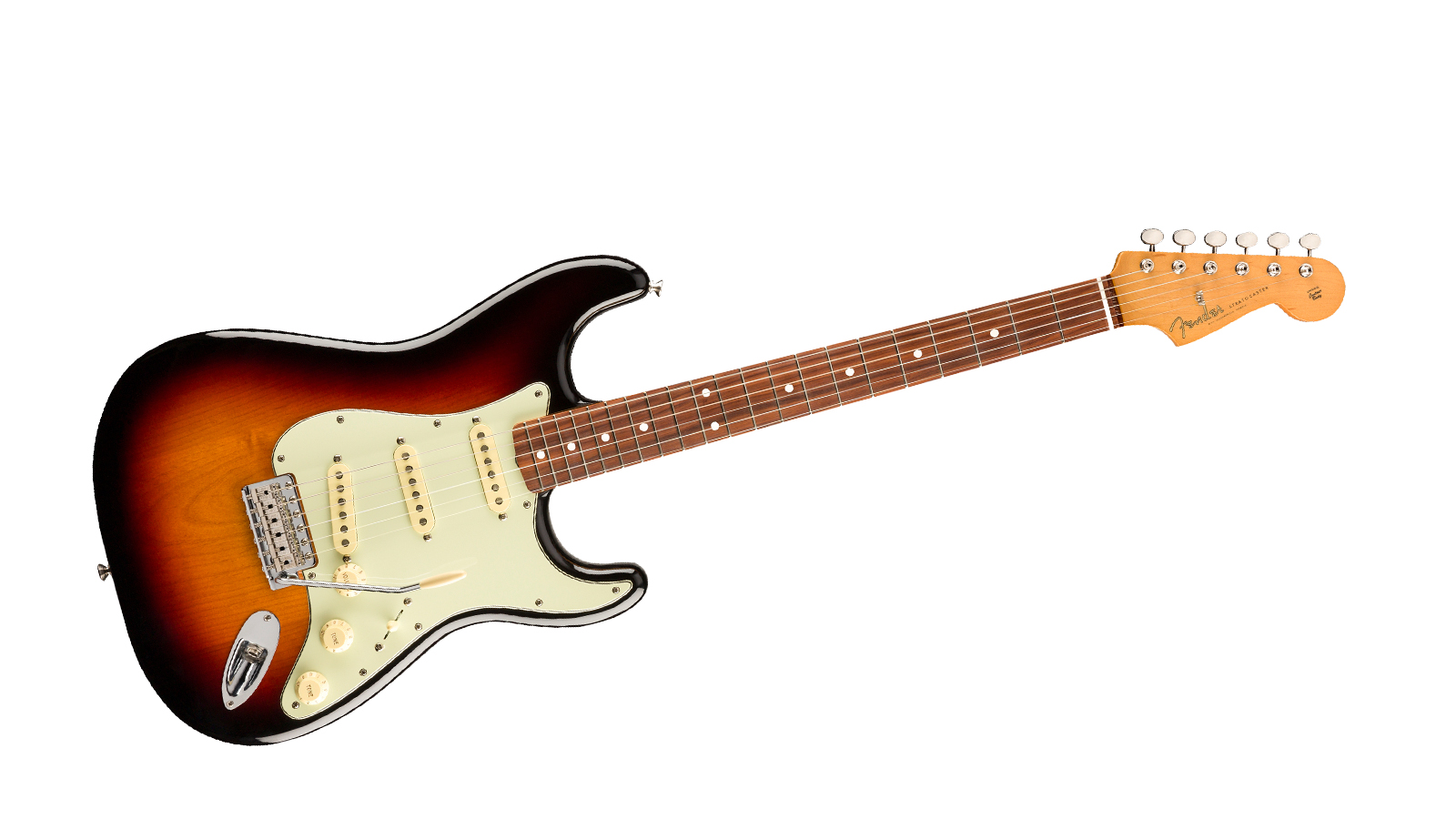
2. Fender Vintera ’60s Stratocaster
Our expert review:
Specifications
Reasons to buy
Reasons to avoid
Fender’s Vintera series is all about rifling through the Big F’s scrapbook for design inspiration and then putting together a vintage-inspired instrument that’s considerably more affordable than a Custom Shop or – gasp – an actual ’60s model. The Mexican-built series has been a huge success, and guitars such as this ’60s Stratocaster are a big reason why.
A show of hands at a Strat owners’ convention would no doubt tell you that the early-’60s Strats were the best of an awesome bunch, and this guitar brings much of that mojo to the table.
The Strat single-coils are designed by Fender pickup guru Tim Shaw, and are textbook Stratocaster. Strap yourself in for some powerful, treble-forward punch at the bridge, funky elasticity in the middle and that spanky bounce at the neck pickup. The five-way selector switch might not be period-accurate, but players such as Hendrix had figured out the workaround for the three-ways, and this saves you the hassle.
The synchronized tremolo is nice and stable, and super-expressive. And while the finish options are a little limited, they’d quite possibly make a Fender highlights reel. Besides, if none are to your liking, the Vintera Road Worn models – a little pricier for all that tender relic’ing – might be more your pace. Either way, this is quite the Strat.
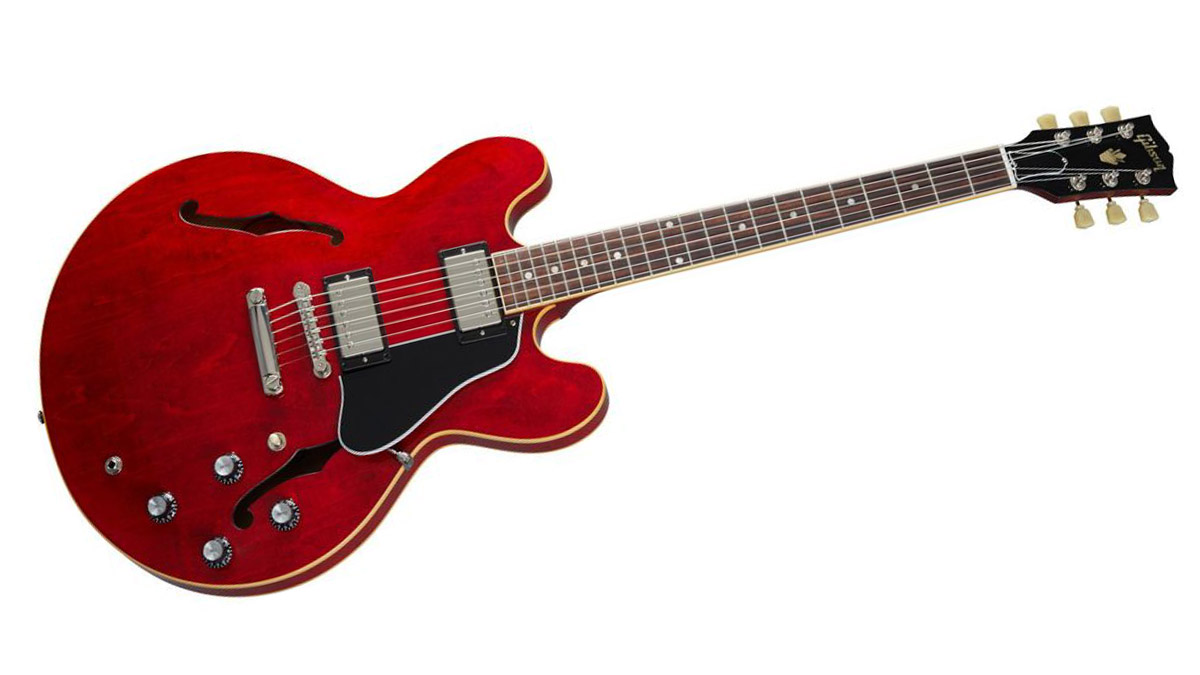
3. Gibson ES-335
Our expert review:
Specifications
Reasons to buy
Reasons to avoid
The ES-335 is one of the most influential designs in electric guitar. Bridging the gap between the large-bodied jazz boxes of yore, the ES-335’s solid- maple center block made it resistant to feedback and perfect for high-volume stages in the company of a band and a loud amplifier.
Few guitars, if any, have been copied more than the ES-335, and the Gibson and Epiphone variants alone are enough to make players dizzy as to which one to choose. The well-heeled might wish to open their pocketbooks in the direction of the newly minted Murphy Lab models, forensically aged for that vintage guitar illusion. But the production-line models are hard to beat, and you can do the aging at your own pace.
Here you have a body of three-ply maple/poplar/maple laminate and a choice of classic finishes. A pair of calibrated T-type humbuckers grace the current models, and are controlled via a hand-wired circuit that features 500K pots and Orange Drop capacitors. Drawing attention to such miscellanea is not cork-sniffing; such quality components ensure that the two-volume, two-tone setup offers fresh sounds with each turn of the knob.
The ES-339 recently returned to the lineup, offering a similar vibe to the ES-335, only with a slightly smaller body – but there’s something undeniably agreeable about the proportions of the latter. Oh, blues tones? No matter where you park that three-way pickup selector, you’ll find something musical and inspiring. Plug it into a Deluxe or a similarly charismatic tube combo and you’ll lose a day.
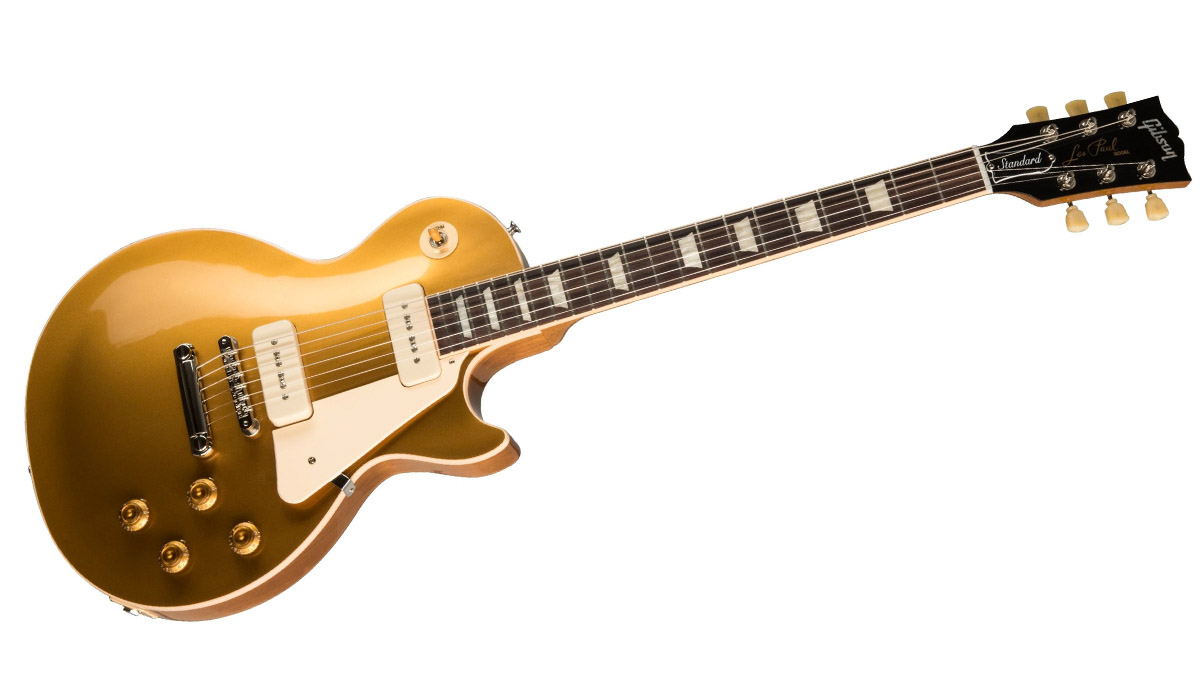
4. Gibson Les Paul Standard ’50s P-90
Our expert review:
Specifications
Reasons to buy
Reasons to avoid
We couldn’t complete a list of the best blues guitars without one P-90 option on the menu. While a Junior would be tempting – certainly for the trigger-fingered rock ’n’ roll players who favor simplicity and lots of it – this ’50s Gold Top with its fat neck, aspirational build and more easily intonated bridge takes the cake.
It’s a phenomenal guitar. Of course, some might say that if you’re buying a Les Paul, why not get one with humbuckers? They’re cool, too, of course, but for us it’s hard to beat the tonal majesty of the P-90-equipped models. What makes P-90s great? They’re single-coils but wider-sounding, more three-dimensional and with a little heat to them. The drawback, of course, is hum. However, if you’re playing the blues, you’re not likely to have a Big Muff in the signal chain, and we’d bet good money that the extra dynamic response – with the P-90s cleaning up beautifully as you roll the volume back – is more than worth a little noise.
Otherwise, it’s business as usual for a ’50s Les Paul. Big neck, big tone, lots of singing sustain – and the sense that this is a guitar to grow old with.
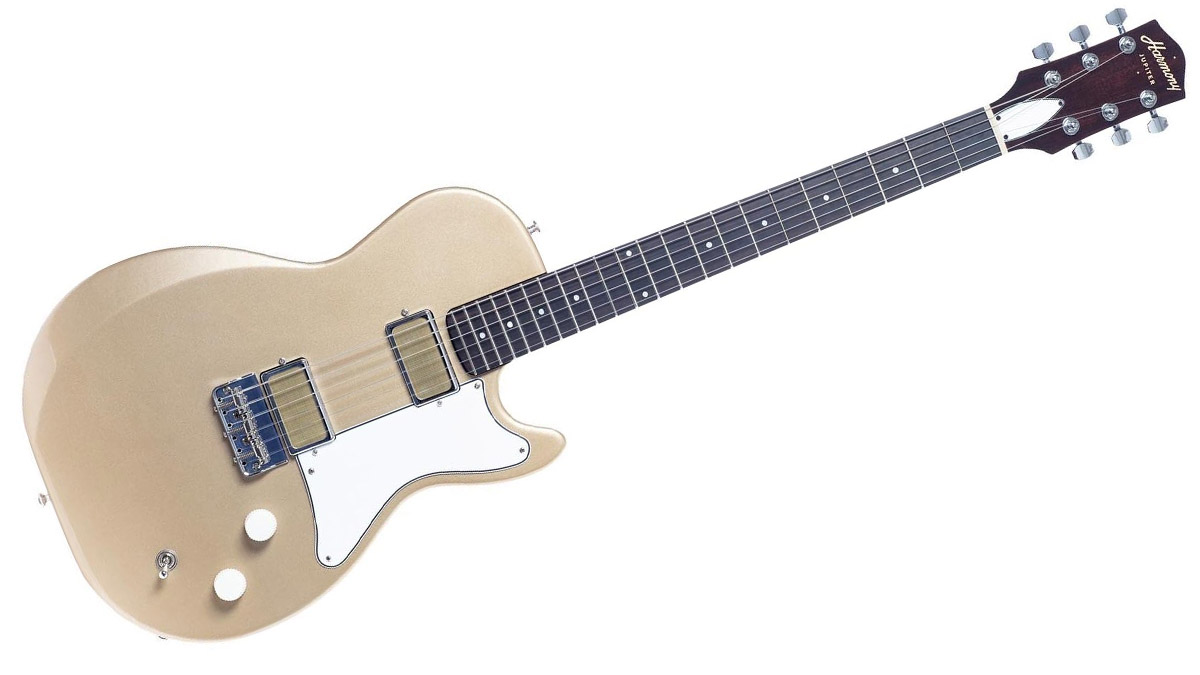
5. Harmony Jupiter
Our expert review:
Specifications
Reasons to buy
Reasons to avoid
The Harmony name is most synonymous with the Meteor that Keith Richards played in the Rolling Stones’ early days. However, the brand has made a somewhat triumphant re-entry into the guitar world of late, with the single-cut Jupiter a genuine USA electric guitar for a little more than a grand.
There’s something gloriously lo-fi about it, with its clean lines and fat mahogany neck joining the body with a three-bolt join. If not pressed into the services of blues guitar, you could see this providing the skronky crunch and almost-twang of garage rock. But it’s the custom-wound gold-foils – wrapped around Alnico 3 magnets and in a circuit with Orange Drop capacitors – that show great potential for blues. There’s something touch-sensitive about gold-foils. With some throaty, mild overdrive and a bit of slide, this guitar could sound sensational if played by the right person. Or, forget the overdrive – those harmonically dynamic and off-piste pickups would be cool in any slide context.
You have three finishes to choose from, each understated and classy, and finished under a layer of gloss nitrocellulose lacquer. Locking tuners should help the guitar hold its tune when you’re bending those notes, too.
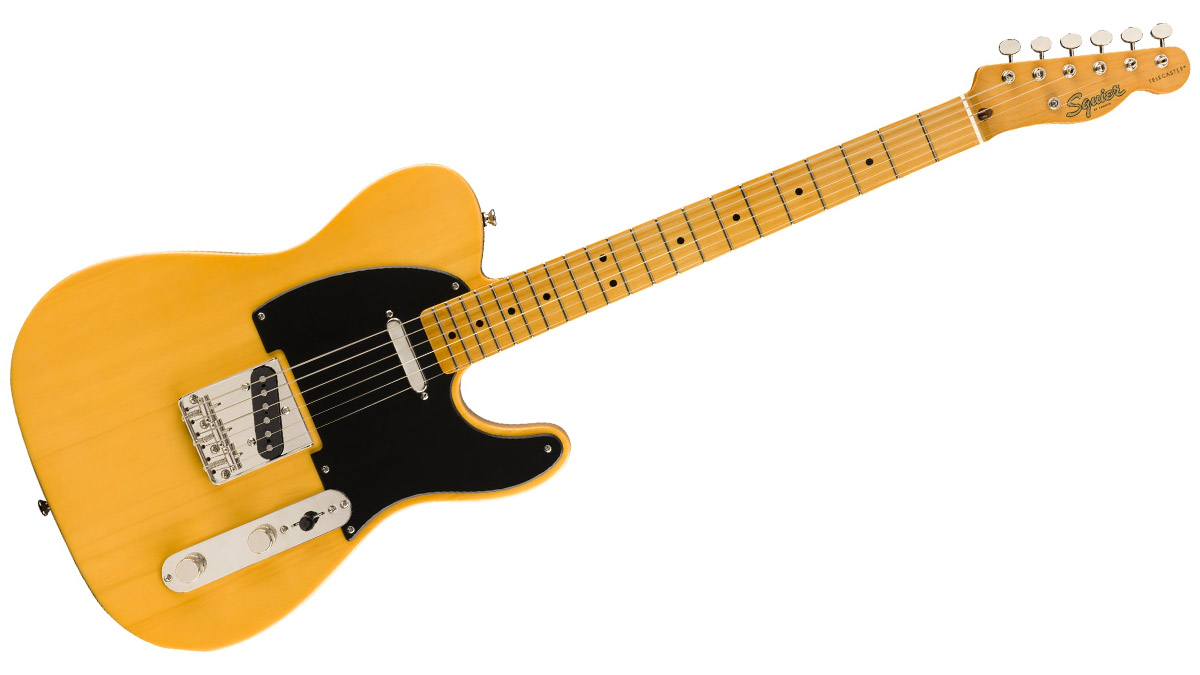
6. Squier Classic Vibe ’50s Telecaster
Our expert review:
Specifications
Reasons to buy
Reasons to avoid
Produced by Fender’s entry-level brand Squier, this ’50s Tele is a blackguard guitar built in the same spirit as the first models to come off the Fender production line in 1951. Here you’ve got a solid slab of pine for the body, with a maple neck bolted onto it. It’s so simple, yet it works.
Those looking for the sweet-honeyed warmth of a B.B. King tone should turn their attention elsewhere. This guitar is all teeth and claws – and, of course, twang. It goes without saying that it works gangbusters for country-blues, but disciples of Albert Collins, Muddy Waters et al would also get a lot of fun out of this.
Though it’s inspired by those ’50s designs, this blackguard is not beholden to era, with Squier choosing a more contemporary 9.5”/24cm fingerboard radius as opposed to the more noticeably curved 7.25”/18.5cm radius ’boards found on the originals. This should suit the contemporary player a little more, while those narrow tall frets are a nice compromise between vintage and modern, leaning a little towards the latter in terms of feel. This guitar is ideal for modding, too, and a set of Fender’s Twisted Telecaster pickups would sound the bee’s knees here.
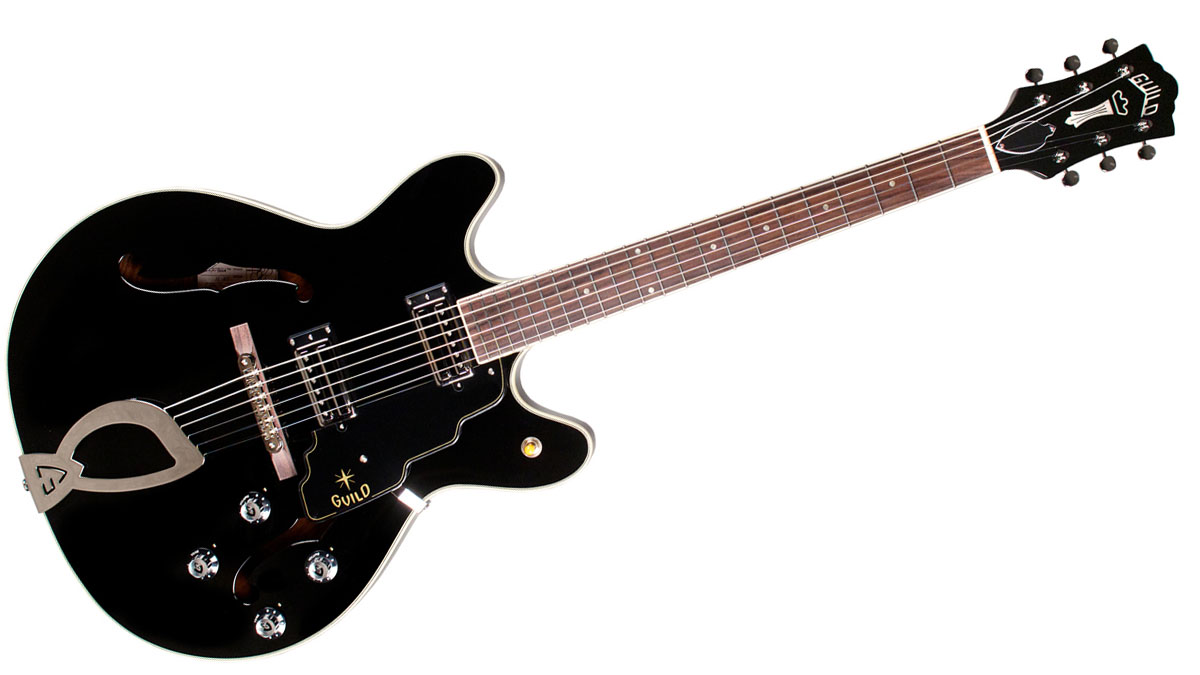
7. Guild Starfire IV
Our expert review:
Specifications
Reasons to buy
Reasons to avoid
These days, the Starfire IV is built in South Korea, but there’s something unmistakably American about the design. Like Epiphone, Guild has been judiciously mining its rich heritage to come out with a number of retro-minded doozies. The Starfire IV is a guitar we’d associate with Buddy Guy. In the ’70s, before his love of polka-dot Strats became his trademark, Buddy rocked the Starfire IV, so you could argue that this guitar had as big a part to play in shaping the Chicago blues sound as Leo Fender’s design.
But this isn’t a competition. Each guitar has its merits. Here we have a thinline design with a pair of LB1 ‘Little Bucker’ humbuckers, and there’s an early rock ’n’ roll vibe to the tone that translates nicely in blues, with plenty of bite to bring out all the detail in your vibrato. The LB1s are certainly a little thicker and warmer than single-coils, but they offer a brighter tone than PAF pickups.
There are plenty of options in the range, with a Bigsby-equipped model coming in at around 400 bucks more. If you’re looking for an alternative to the Fender/Gibson paradigm, you can’t go wrong with Guild.
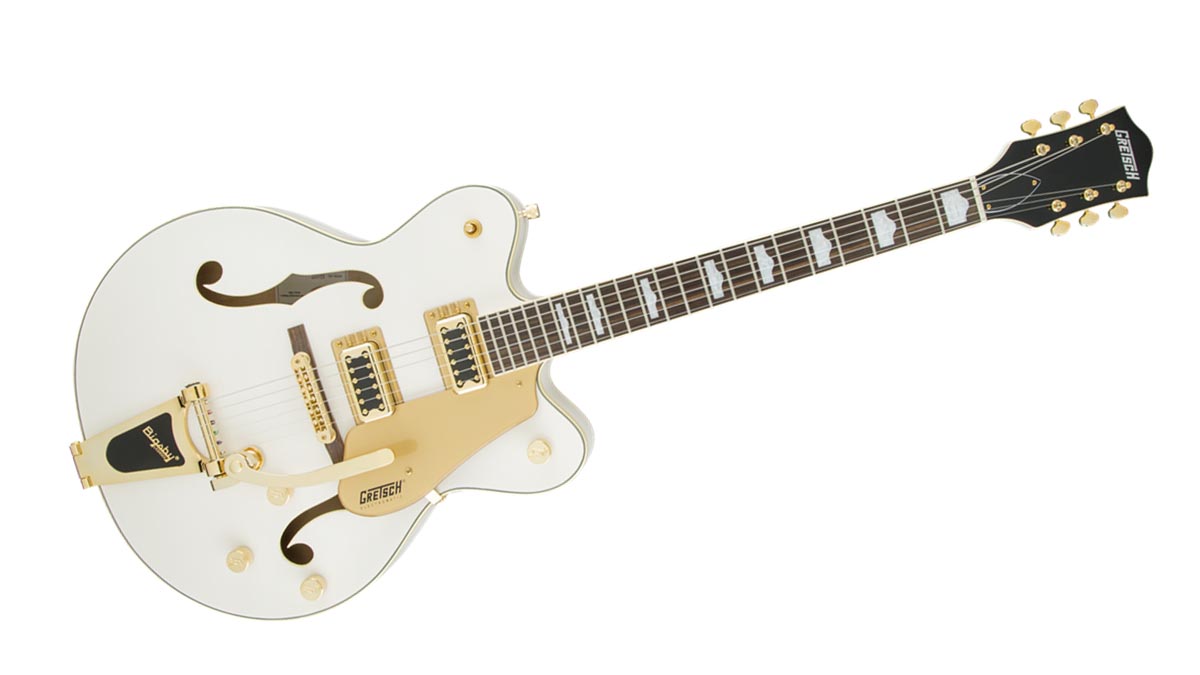
8. Gretsch G5422TG
Our expert review:
Specifications
Reasons to buy
Reasons to avoid
We often find ourselves explaining that Gretsch doesn’t just make rockabilly guitars, before talking about how the US brand’s various semi-hollow electric builds are the cat’s pyjamas for all things inspired by Eddie Cochrane. But it’s true that they’re not just rockabilly guitars – and besides, blues tone is just a stone’s throw from rock ’n’ roll.
We love the G5422TG. This hollowbody doublecut is a prime example of how Gretsch’s South Korean-built Electromatic series preserves the brand’s heritage, yet is priced for those looking for their first serious guitar.
It comes equipped with a pair of Gretsch’s ‘Black Top’ Filter'Tron humbuckers, though these are quite different from your everyday PAF-alikes. They put a little more high-end sting into your tone – the patented Gretsch twang, if you will – and for blues, that makes a quite tantalizing tonal proposition. Dial in a little spring reverb, bounce the selector to the neck pickup, and you’ll have a sweet, mellow and resonant sound to take to the BB box. The four-ply body binding, the bound ’50s-style headstock and neck, and the pearloid hump block inlays put the finishing touches on what is one of the most aesthetically pleasing guitars at this or any other price.
Read the full Gretsch G5422TG review
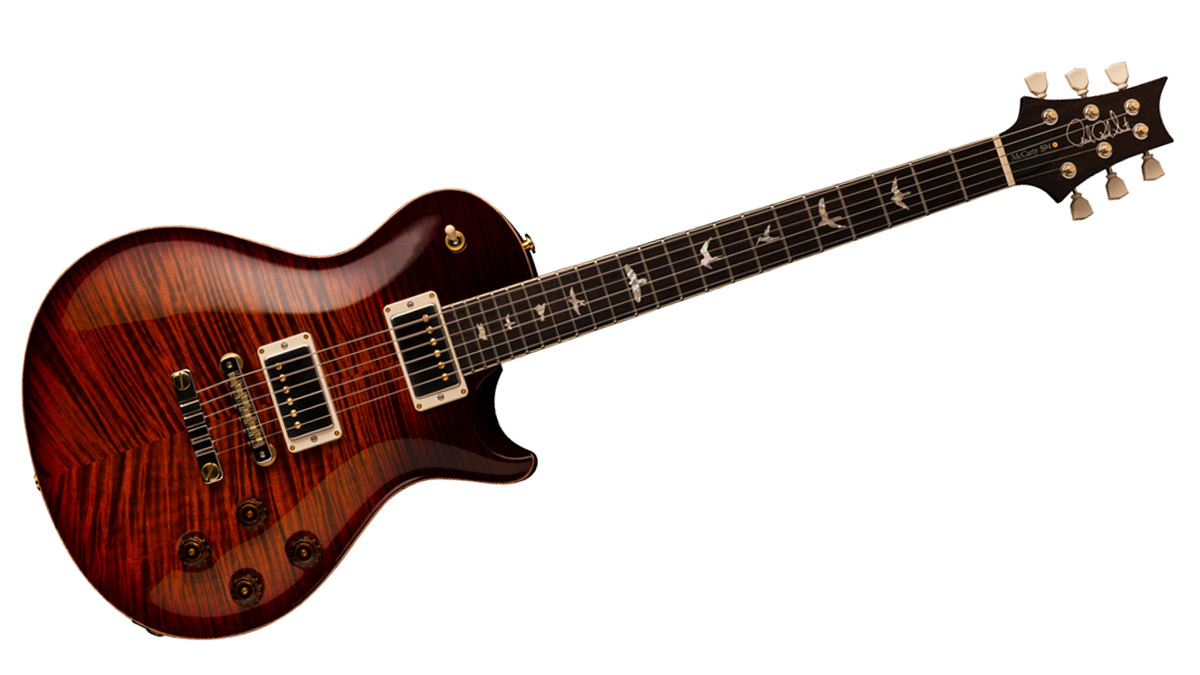
9. PRS McCarty 594 Singlecut
Our expert review:
Specifications
Reasons to buy
Reasons to avoid
Born too late for blues but made just right for late-night adventures under the lights, playing 5s and 7s with a boogie-woogie trio – perhaps this is the McCarty 594 Singlecut’s blues origin story. It would be a crime if this guitar were to be overlooked, because in many respects it’s a contemporary blues-rock Excalibur; if you were building a blues guitar from the ground up right now, it might well look like this.
Taking its name from the 24.594” (62.5cm) scale length, the McCarty 594 Singlecut follows a familiar tonewood recipe, with a generously thick piece of mahogany topped by a similarly generous figured maple cap. This being PRS, the myriad finish options bring out every bit of detail in that glorious maple. The ’59 Les Paul Standard is clearly the inspiration here, though it’s neat to see someone shoot for that tone profile and feel in what is quite a different guitar. There’s no mistaking the PRS touches, from the open-gear Phase III locking tuners to the forensic intonation care of the supremely well-engineered bridge and birds inlay on the fingerboard.
Blues guitar comes with a whiff of snobbery, but wrapping the fretting hand around the asymmetrical Pattern Vintage neck should see that subside in no time. This is a player’s guitar. Pricey, but then you often get what you pay for. Again, when compared with the vintage market, the asking price is more than reasonable. The 58/15 LT (Low Turn) pickups are super- articulate, offering a classic humbucker tone and with some bright single-coil tones accessible via the push-pull tone knobs.
Read the full PRS McCarty 594 Singlecut review
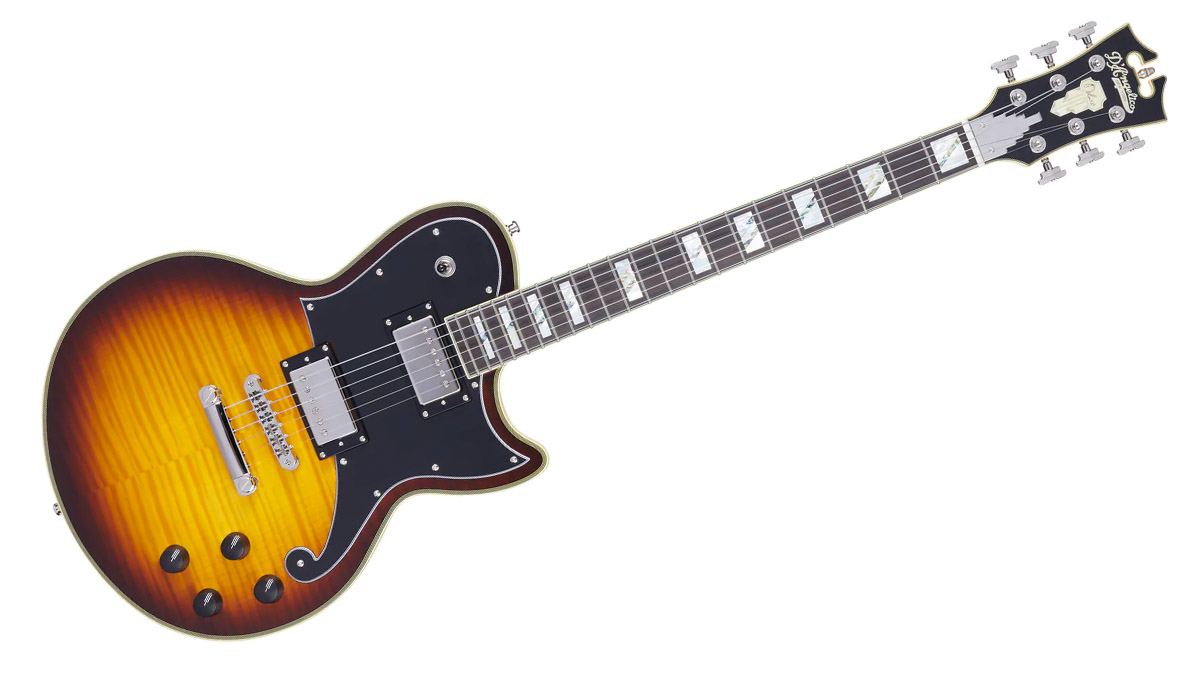
10. D’Angelico Deluxe Atlantic
Our expert review:
Specifications
Reasons to buy
Reasons to avoid
The Deluxe Atlantic is not the first solidbody singlecut to be influenced by the Les Paul, and it won’t be the last, but it might just be one of the most attractively priced and imaginatively spec’d that we’ve seen in many a year. Indeed, that body shape owes a little to the Telecaster, too – just look at the carve opposite the cutaway. It’s the guitar of many curves, and while the D’Angelico headstock is a little on the rococo side for our blue-collar tastes, it’s traditional for the New York brand.
The Deluxe Atlantic is a diverse beast. Of course, this is a blues guitar buyer’s guide and that’s what we are primarily interested in here, but it’ll handle rock, jazz and pop, too. It’s just that the swamp ash and maple top make a lovely tonewood combination for blues, especially with the set of Seymour Duncan Seth Lover humbuckers on board.
You’ll have no problem dialing in a Clapton-esque ‘woman tone’ here, or some biting overdrive for stinging leads. And for those occasions when you need a bit more clarity and sharpness, there’s a coil-tap in that control circuit. Wonderful.
Read the full D’Angelico Deluxe Atlantic review
Best blues guitars: Buying advice

The very idea of having a guitar for playing the blues is a modern concept. The founding fathers of the blues didn’t have any choice in the matter. Electric blues was a paradigm shift for the art form and instrument alike. When Muddy Waters tuned his Gretsch Synchromatic to open-G for his legendary 1948 recording of I Can’t Be Satisfied, there wasn’t a whole industry catering to him – he was literally inventing the tone. Scratchy, hot, overdriven, Mud’s tone was like seeing color on a TV set for the very first time. Even then, he used an aftermarket DeArmond pickup because the stock pickup wasn’t cutting it. Times were changing, however, and changing fast.
The new solid-bodied electric guitars pioneered by the likes of Leo Fender, Les Paul and Ted McCarty throughout the ’50s – not to mention the evolution in guitar amplifier design – ushered in a new era. Blues players seized the day.
By the turn of the ’60s, there were options. Players had different builds to choose from and, crucially, pickups. There were single-coils with stinging tone. Humbuckers injected warmth, width and some saturated fat. There was the P-90 – a hot soup of bright harmonics and punchy mids. Gold-foils, Dynasonics… They were all out there, extending the range of blues tone. Furthermore, it was the era when the electric guitar archetypes – the Les Paul, the Tele, the Strat et al – were established.
What makes a great blues guitar?
You can trust Guitar World
Stick a pin in the electric guitar’s history at 1972 and you would have all the blues guitars you needed. The form was perfected. The sound was established. In many respects, that shapes our search today, because the best blues guitars are all building upon those very same design fundamentals that were pioneered in the pre-digital era. The challenge for today’s builders is to improve upon them.
Blues comes with a certain historical weight but, as with any gear hunt, it all comes down to you. You’re the one who’ll be playing it, and your style is unique. The best blues guitar is the one that best lets you express yourself – every guitar on the shelf has the 5s, 7s and 8s, the blues box is available on all fretboards, but we’re looking for a specific sound and feel.
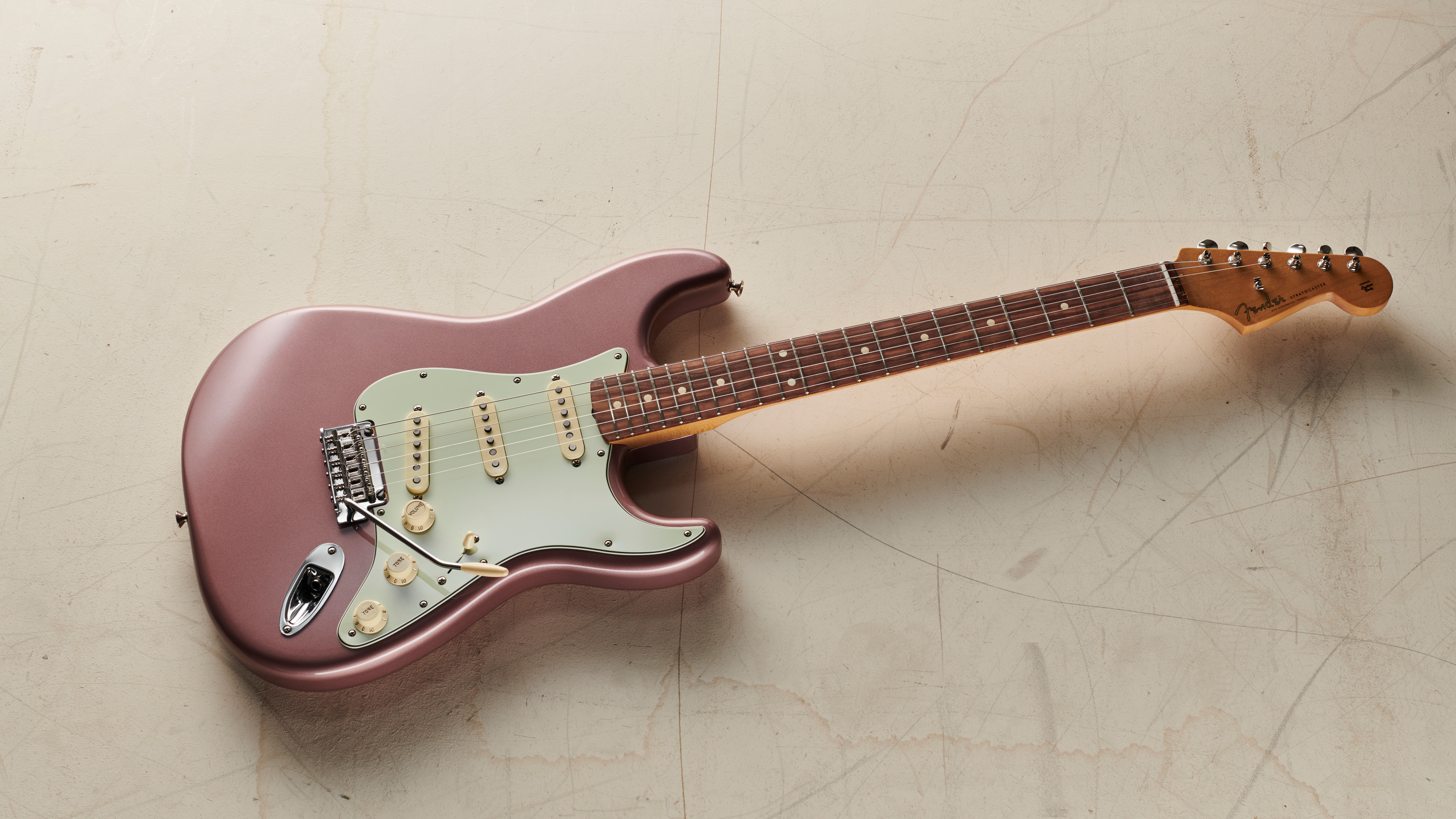
The search for tone: single-coils vs humbuckers, Fender vs Gibson
What sort of tone are you looking for? Options are good but they aren’t everything – not if you’re a specialist. There are some blues players who would be happy with the single-coil sting of the Fender Esquire’s bridge pickup. Sometimes, all you need is a hit of Albert Collins ice-pick treble to pierce the mix and pin the audience to the back of their seats when leaning into a bend.
But the Telecaster’s neck pickup, with its fully midrange and elastic bounce, offers a fruity complementary tone, not to mention that mix position that works so well for playing rhythm. Just as no tool box is complete without a hammer, no list of best guitars – especially in a foundational art form such as the blues – could be complete without a Telecaster.
Searching for blues tones often begins with looking at the aforementioned electric guitar archetypes and working outwards, to see what else works. Expanding on the Telecaster theme, the Stratocaster’s trio of single-coils offer a whole suite of tone options that the likes of Buddy Guy, Otis Rush and Stevie Ray Vaughan were quick to pick up on.
Access to those in-between tones gives Strat players an advantage when seeking out nuances and dynamics in their performances. There’s also no denying the power of a Strat single-coil played through a tube amp pushed to breaking point, nor the subtlety of that neck/middle combo. The Fender Stratocaster brings options and lots of them.
Crossing the aisle to the Gibson camp, where the PAF humbucker upended the guitar player’s tone menu, you’re looking at more width, more warmth, more body in the tone, and a little more power for driving the front end of your amp. The classic Gibson control circuit, with each humbucker having its own individual volume and tone controls, is an onboard EQ section that affords players a huge variety of sounds before they even touch a dial on their amplifier.
Looking beyond Fender and Gibson
If the greats all played Fenders and Gibsons, then why look anywhere else? We could, of course, fill this list with either or. But innovation is everywhere in guitar design. The likes of Gretsch and Guild offer that same old-school prestige, and yet something different in their tones, something that could well speak to you. After all, that’s the only thing that matters.
While the notion of a grizzled old blues player and their guitar seems like one that can only exist in legend, modern builds from the likes of Paul Reed Smith and D’Angelico are puncturing such thinking. Indeed, why not have coil-taps on a solidbody format that, once upon a time, was influenced by the Les Paul?
There will always be room for improvement when it comes to build, whether that’s in a newly engineered bridge system or in pickups with a wider dynamic range. This is the business of making music and the future is always up for grabs, even when aligned against the storied tide of blues history.
All the latest guitar news, interviews, lessons, reviews, deals and more, direct to your inbox!
Jonathan Horsley has been writing about guitars since 2005, playing them since 1990, and regularly contributes to publications including Guitar World, MusicRadar and Total Guitar. He uses Jazz III nylon picks, 10s during the week, 9s at the weekend, and shamefully still struggles with rhythm figure one of Van Halen’s Panama.

